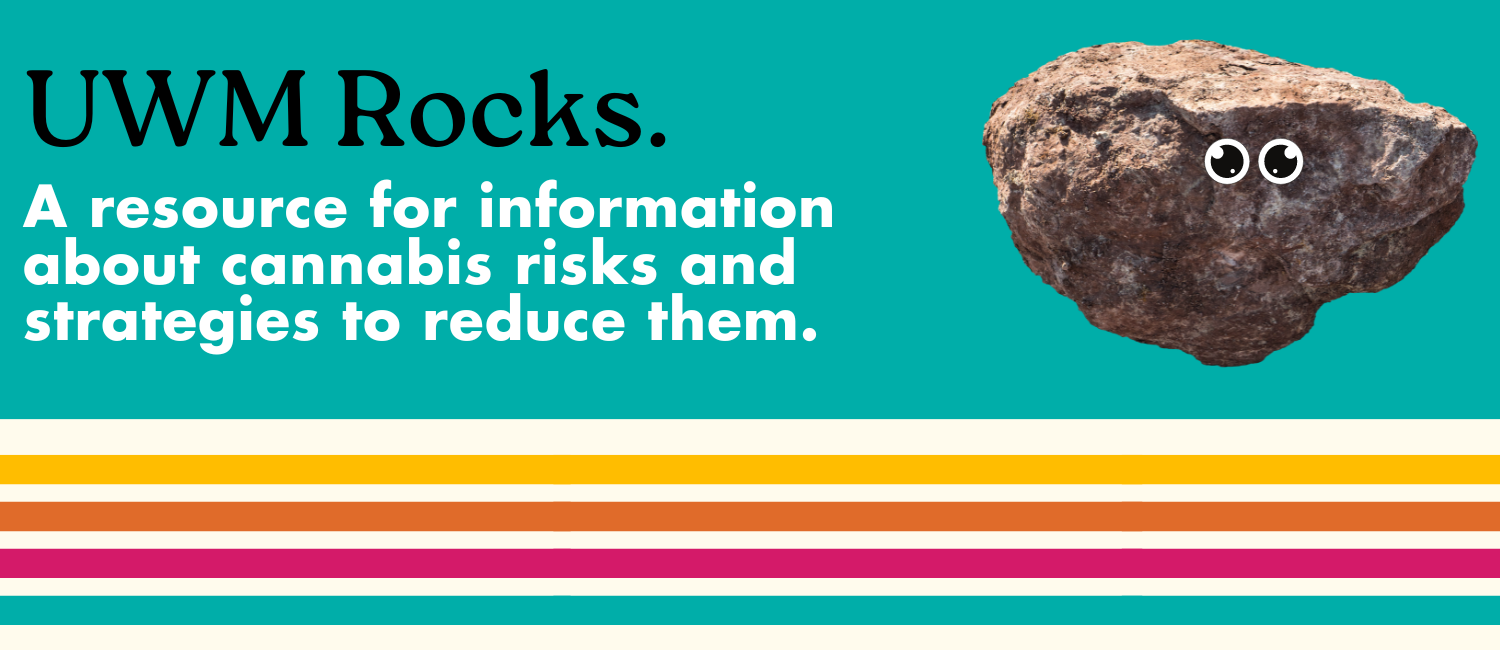What is Cannabis?
Cannabis (also known as marijuana, weed, or pot) refers to the dried leaves, flowers, stems, and seeds from the cannabis plant. The cannabis plant contains more than 100 compounds (or cannabinoids). These compounds include delta-9 tetrahydrocannabinol (THC), which is impairing or mind-altering, as well as other active compounds, such as cannabidiol (CBD). CBD is not impairing, meaning it does not cause a “high”.
Did you find a rock?!
If you found one of these rocks, take it home, care for it, love it – it’s yours. Post a selfie with your new rock friend with #uwmrocks and tag the Student Health and Wellness Center on Instagram @uwm_wellness.
While you’re here, read on to learn about the potential risks of cannabis use and how to lower those risks. Whenever you have questions, scan the QR code on your rock to get back to this page.
If you or someone you know needs support cutting back on or quitting cannabis, reach out to the Student Health and Wellness Center for confidential, nonjudgemental support.

The risk of adverse effects varies in likelihood and severity depending on the person, product, and patterns of use. This risk goes up as the frequency of use and/or potency of THC goes up. The younger the consumer, the higher the risk of adverse effects.
Health risks include:
- Impaired cognitive functioning (memory, learning, attention)
- Cannabis use disorder/dependence
- Worse respiratory symptoms and more frequent chronic bronchitis
- Mental health problems (e.g. social anxiety, paranoia, suicidality, schizophrenia)
- Motor vehicle crashes
- Low birth weight of newborns
A note about potency: Cannabis concentrates (e.g. wax, shatter, resin, rosin, hash oil, extracts) have the highest THC potency. These products are commonly consumed through a process called dabbing or by using a vape pen, and are linked with a greater risk for anxiety, agitation, paranoia, psychosis, and, for regular users, addiction.
Some signs and symptoms of CUD include craving cannabis, experiencing withdrawal symptoms* when trying to stop or cut back, neglecting obligations, and difficulty controlling use. If you experience any of these signs or if you feel suicidal, seek help immediately.
*Withdrawal from cannabis can cause irritability, difficulty sleeping, lack of appetite, increased anxiety, vivid dreams, mood swings, headaches, tiredness, and physical discomfort such as hot and cold flashes.
Are you concerned about your cannabis use? Complete the CUDIT-R to assess your use.
In the US, the sale of hemp products is legal if they contain less than 0.3% delta-9 THC, the main ingredient in cannabis that makes a person feel high. There are other chemicals (cannabinoids) produced naturally in the cannabis plant (such as delta-8 and delta-10) that can cause the consumer to feel high, but they are only found in trace amounts. To achieve the concentrations claimed in the marketplace, delta-8 THC products are typically manufactured from hemp-derived cannabidiol (CBD).
It’s important for consumers to know that delta-8 THC and similar products have not been evaluated or approved by the FDA for safe use in any context, and they may be marketed in ways that put the public health at risk.
Here’s what else you need to know:
Unregulated Production: Manufacturers may use unsafe household chemicals to convert other cannabinoids into delta-8 THC. The final product may have potentially harmful by-products (contaminants) due to the chemicals used in the process. Additionally, the manufacturing process is unregulated and may occur in uncontrolled or unsanitary settings.
Unreliable Labeling: There is concern over the variability in labeling and concentrations of delta-8 THC may not match what is claimed on the label. Delta-8 THC is psychoactive, meaning it can cause the consumer to feel high. Without quality control systems in place, it is impossible to know the potency (strength) or purity of the product. Simply put, you can’t be sure what you’re getting.
Unpredictable Effects: Some people who used delta-8 THC or similar unregulated hemp products have experienced adverse effects, including vomiting, difficulty breathing, anxiety, disorientation, lack of coordination, increased heart rate progressing to slow heart rate, sedation, and loss of consciousness.
This information is adapted from the FDA consumer update, “5 Things to Know about Delta-8 Tetrahydrocannabinol – Delta-8 THC.” For more information, visit 5 Things to Know about Delta-8 Tetrahydrocannabinol – Delta-8 THC | FDA
Just as you care for a beloved inanimate pet rock, you should also care for yourself. Plus, pet rocks are fun! Keep an eye out – you just may see some pet rocks popping up across campus.

Strategies to Lower Health Risks
Please note: The use, possession and distribution of cannabis is illegal in the state of Wisconsin. People who violate local, state, or federal laws and policies are subject to fines and penalties. These recommendations offer potentially helpful tips to reduce the risk of adverse health outcomes from cannabis use among (especially, young) users.
There is no universally safe level of cannabis use. The only reliable way to avoid any risk of harm from using cannabis is to abstain from use. Use is especially discouraged for certain groups of people, including people under the age of 25, pregnant people, and people with a personal or family history of psychosis, mood disorder, substance use disorder, or pre-existing cardiovascular risks.
Even if you’ve already used, consider delaying further use at least until age 25. The human brain continues to develop into the mid-twenties, creating unique developmental health and well-being risks for younger users.
If you are experiencing cognitive issues with memory, attention, or concentration, feeling more depressed and anxious, having problems with school, or if you’re simply considering changing the way you use cannabis, we recommend starting with a tolerance break, or a t-break.
A tolerance break can be a good opportunity to evaluate your relationship with cannabis. Since it takes about 3 weeks for THC to leave the body, a tolerance break should be at least 21 days. For some, they may find they like how they feel without cannabis, and the break can just continue. For others, they can bring down their tolerance and find a better balance if they go back to cannabis.
The University of Vermont created a free, downloadable T-Break Guide to help support you on a cannabis tolerance break.
While it is true that cannabis is a plant that has been cultivated around the world for thousands of years, many strains of cannabis available today are far more potent than they once were. This means they have a higher concentration of THC, the psychoactive compound found in cannabis.
Cannabis with over 10% THC is considered high potency. Cannabis concentrates (e.g. wax, shatter, resin, rosin, hash oil, extracts) have the highest THC potency. These products are commonly consumed through a process called dabbing or by using a vape pen, and are linked with a greater risk for anxiety, agitation, paranoia, psychosis, and, for regular users, addiction. Frequent use of high-potency cannabis is associated with a greater risk of physical and mental health problems.
If you choose to use, the safest place to obtain cannabis is from a licensed dispensary in a state where cannabis is legal. These products are regulated and list their potency on the label.
Cannabis from any other sources is unregulated and may contain harmful chemicals and be stronger/more potent than expected. Put simply, you cannot be sure what you’re getting. There have been reports of cannabis laced with additional substances, including fentanyl, which can be lethal even in very small amounts. People who use cannabis from unregulated sources should carry NARCAN (a lifesaving medication that can reduce opioid overdose) and should never use alone.
For more information about fentanyl and drug lacing, visit the CDC’s fentanyl information page.
Using cannabis and other substances together can magnify the risks for a variety of outcomes, including dependence, pulmonary and reproductive health issues, and, with alcohol specifically, increased impairment.
While cannabis may help some people fall asleep faster, using before bed deprives a person of REM (Rapid Eye Movement) sleep1. This REM deprivation can lead to an increase in daytime sleepiness, anxiety, irritability, and jumpiness. Because REM also supports creativity and problem-solving, cannabis can negatively impact your academic performance.
Cannabis can be used in a number of ways and all modes of use come with downsides. Using more than one way is associated with a greater risk of cannabis-related problems.
| Mode of Use | Risks of Mode of Use |
|---|---|
| Smoking Cannabis | – Significant increase in risk of cough, mucus production, wheezing, and shortness of breath. – Increased risk of chronic bronchitis and other respiratory illnesses. |
| Vaping Cannabis | – Typically involves high potency extracts which are associated with higher levels of short- and long-term mental health effects. – Cannabis extract products have been found to contain contaminants, such as pesticides, residual solvents, heavy metals, or bacteria and fungi. – Toxins from flavoring agents can cause inflammation of the airways. |
| Ingesting (eating or drinking) Cannabis | – Delayed onset of psychoactive effects (1-2 hours) can lead to over-consumption. – Harder-to-control dosing increases the risk of unexpected levels of intoxication, including overdose experiences. – Can cause sleepiness, nausea, anxiety, and hallucinations. – Longer duration of effects (6-12 hours or more). |
Resources
Sources
Fisher B, et al. Lower-Risk Cannabis Use Guidelines for Reducing Health Harms from Non-medical Cannabis Use: A comprehensive evidence and recommendations update. Intl J Drug Policy. 2022. | National Academics of Sciences, Engineering, and Medicine. 2017. The health effects of cannabis and cannabinoids: The current state of evidence and recommendations for research. Washington, DC: The National Academics Press.
1 Angarita, Gustavo & Emadi, Nazli & Hodges, Sarah & Morgan, Peter. (2016). Sleep abnormalities associated with alcohol, cannabis, cocaine, and opiate use: a comprehensive review. Addiction Science & Clinical Practice. 11. 10.1186/s13722-016-0056-7.
2 B Han, WM Compton, EB Einstein, ND Volkow. Associations of Suicidality Trends With Cannabis Use as a Function of Sex and Depression Status. JAMA Network Open. DOI: 10.1001/jamanetworkopen.2021.13025 (2021).
